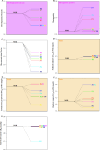Effect of Fluorine Atoms and Piperazine Rings on Biotoxicity of Norfloxacin Analogues: Combined Experimental and Theoretical Study
- PMID: 39722844
- PMCID: PMC11667292
- DOI: 10.1021/envhealth.4c00095
Effect of Fluorine Atoms and Piperazine Rings on Biotoxicity of Norfloxacin Analogues: Combined Experimental and Theoretical Study
Abstract
To clarify the effect of the fluorine atom and piperazine ring on norfloxacin (NOR), NOR degradation products (NOR-DPs, P1-P8) were generated via UV combined with hydrogen peroxide (UV/H2O2) technology. NOR degradation did not significantly affect cytotoxicity of NOR against BV2, A549, HepG2, and Vero E6 cells. Compared with that of NOR, mutagenicity and median lethal concentration of P1-P8 in fathead minnow were increased, and bioaccumulation factor and oral median lethal dose of P1-P8 in rats were decreased. Molecular docking was used to evaluate the inhibitory effect of DNA gyrase A (gyrA) on NOR-DPs to determine the molecular-level mechanism and establish the structure-activity relationship. Results indicated that the most common amino acid residues were Ile13, Ser27, Val28, Gly31, Asp36, Arg46, Arg47, Asp157, and Gly340; hydrogen bonds and hydrophobic interactions played key roles in the inhibitory effect. Binding area (BA) decreased from 350.80 Å2 (NOR) to 346.21 Å2 (P1), and the absolute value of binding energy (|BE|) changed from 2.53 kcal/mol (NOR) to 2.54 kcal/mol (P1), indicating that the fluorine atom mainly affects BA. The piperazine ring clearly influenced BA and |BE|. "Yang ChuanXi Rules" were used to explain effects of molecular weight (MW), BA, |BE|, and sum of η1 + η2 (η1: normalization of BA, η2: normalization of |BE|) and predict biotoxicity of NOR-DPs based on half-maximum inhibitory concentration (IC50), half-minimal inhibitory concentration (MIC50), and half-minimal bactericidal concentration (MBC50) values.
© 2024 The Authors. Co-published by Research Center for Eco-Environmental Sciences, Chinese Academy of Sciences, and American Chemical Society.
Conflict of interest statement
The authors declare no competing financial interest.
Figures





Similar articles
-
Identification of novel DNA gyrase inhibitor by combined pharmacophore modeling, QSAR analysis, molecular docking, molecular dynamics, ADMET and DFT approaches.Acta Trop. 2024 Dec;260:107460. doi: 10.1016/j.actatropica.2024.107460. Epub 2024 Nov 10. Acta Trop. 2024. PMID: 39527993
-
Identification of potent aldose reductase inhibitors as antidiabetic (Anti-hyperglycemic) agents using QSAR based virtual Screening, molecular Docking, MD simulation and MMGBSA approaches.Saudi Pharm J. 2022 Jun;30(6):693-710. doi: 10.1016/j.jsps.2022.04.003. Epub 2022 Apr 7. Saudi Pharm J. 2022. PMID: 35812153 Free PMC article.
-
Palladium-arene interactions in catalytic intermediates: an experimental and theoretical investigation of the soft rearrangement between eta1 and eta2 coordination modes.J Am Chem Soc. 2002 Apr 24;124(16):4336-46. doi: 10.1021/ja016587e. J Am Chem Soc. 2002. PMID: 11960463
-
Norfloxacin, a fluoroquinolone antibacterial agent. Classification, mechanism of action, and in vitro activity.Am J Med. 1987 Jun 26;82(6B):3-17. doi: 10.1016/0002-9343(87)90612-7. Am J Med. 1987. PMID: 3111257 Review.
-
Pharmacokinetics of gyrase inhibitors, Part 2: Renal and hepatic elimination pathways and drug interactions.Am J Med. 1993 Mar 22;94(3A):56S-69S. Am J Med. 1993. PMID: 8383921 Review.
References
-
- Kumar M.; Sridharan S.; Sawarkar A. D.; Shakeel A.; Anerao P.; Mannina G.; Sharma P.; Pandey A. Current research trends on emerging contaminants pharmaceutical and personal care products (PPCPs): A comprehensive review. Sci. Total Environ. 2023, 859, 160031.10.1016/j.scitotenv.2022.160031. - DOI - PubMed
-
- Chen X. X.; Fu W. Y.; Yang Z. C.; Yang Y. L.; Li Y. J.; Huang H.; Zhang X. H.; Pan B. C. Enhanced H2O2 utilization efficiency in Fenton-like system for degradation of emerging contaminants: Oxygen vacancy-mediated activation of O2. Water. Res. 2023, 230, 119562.10.1016/j.watres.2022.119562. - DOI - PubMed
LinkOut - more resources
Full Text Sources
Research Materials
Miscellaneous
